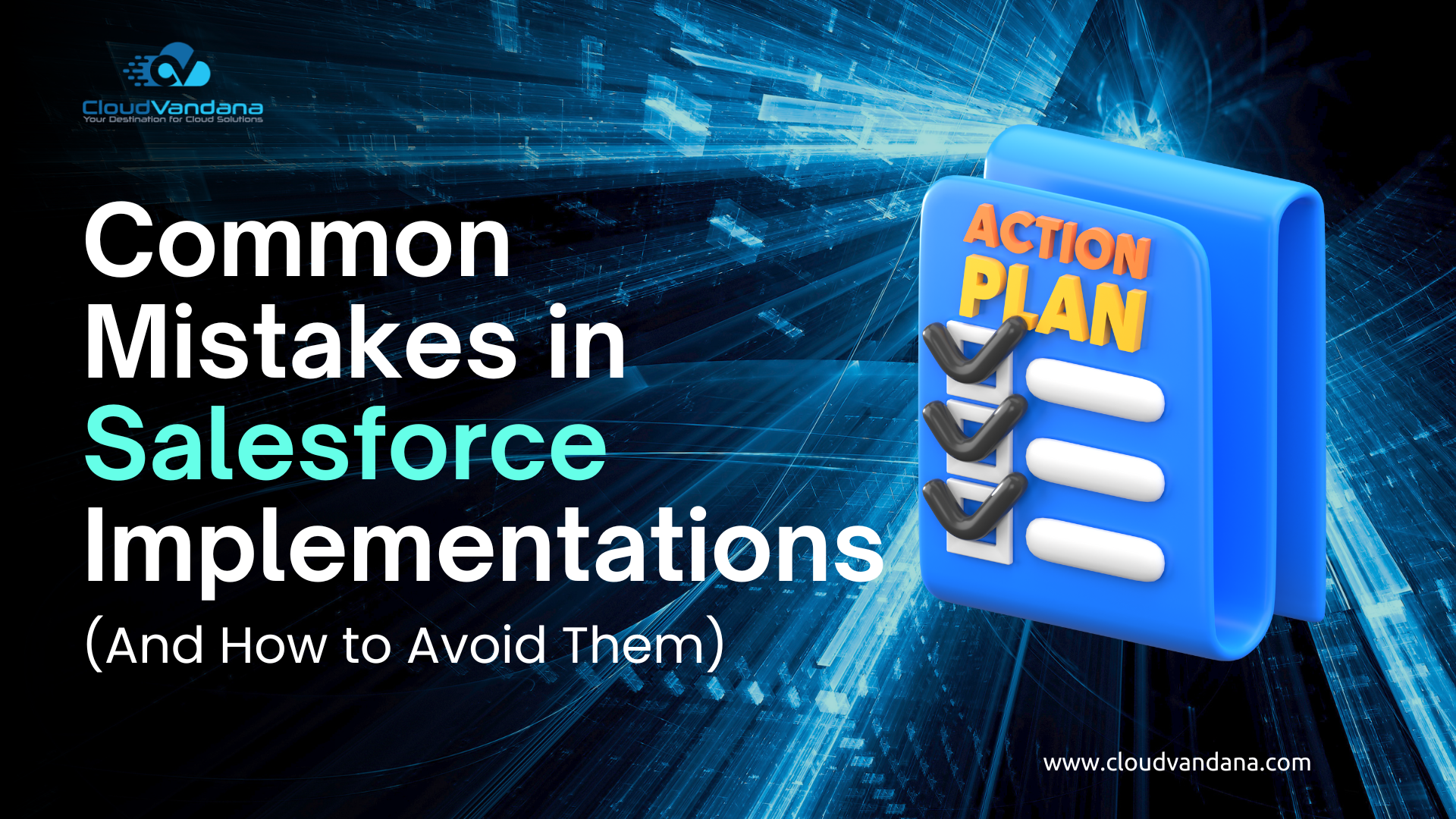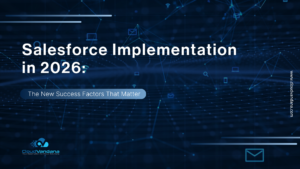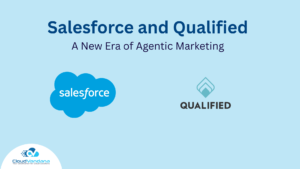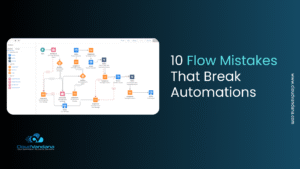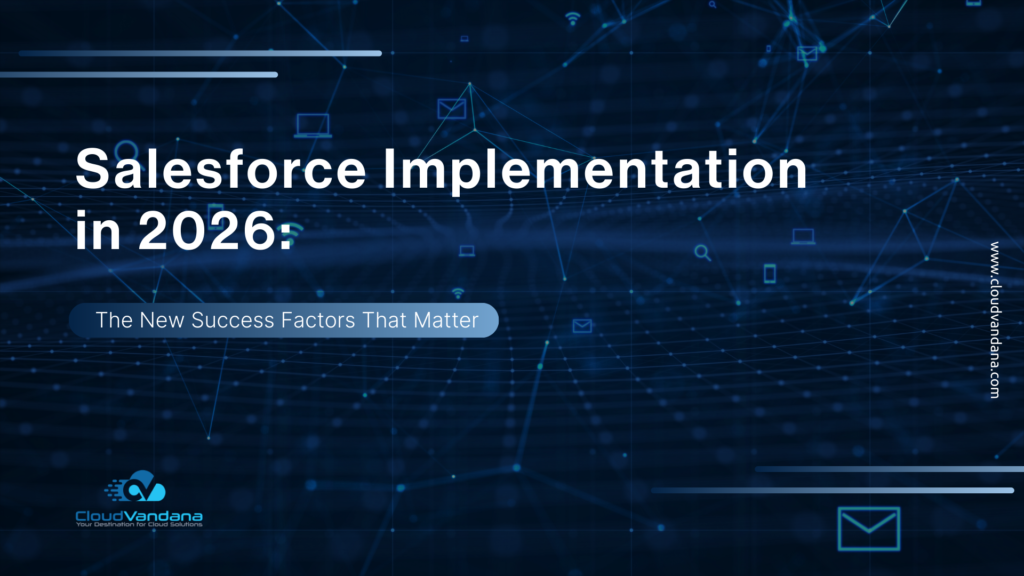Introduction: The Promise and Pitfalls of Salesforce
Salesforce dominates the CRM market because it does more than manage customer information—it orchestrates business transformation. From sales to service, marketing to analytics, the platform has become the digital backbone of ambitious organizations worldwide. Yet for every success story, there are tales of disillusionment: stalled rollouts, frustrated employees, ballooning budgets, and underwhelming returns.
The irony is striking. A platform built to unify business operations often ends up sowing fragmentation when implemented carelessly. The gap between Salesforce’s potential and the reality of many failed implementations is not caused by the technology itself but by human missteps. Misaligned priorities. Short-term thinking. Neglect of fundamentals.
The good news? These mistakes are not inevitable. They are patterns—predictable, repeated across industries and regions. Which means they are avoidable. The following guide examines the most common mistakes in Salesforce implementations and offers strategies to prevent them, so the platform becomes not a burden, but a competitive advantage.
Table of Contents
- Introduction: The Promise and Pitfalls of Salesforce
- Rushing Through Discovery Without a Clear Vision
- Underestimating the Importance of Data Quality
- Ignoring Stakeholder Alignment
- Over-Customization of the Platform
- Neglecting User Adoption
- Failing to Prioritize Change Management
- Misjudging Integration Complexity
- Inadequate Security and Compliance Planning
- Skipping a Phased Rollout
- Not Accounting for Scalability
- Overlooking Reporting and Analytics Setup
- Poor Vendor or Partner Selection
- Unrealistic Timelines and Budgets
- Neglecting Mobile-First Experience
- Weak Governance Structures
- Failure to Leverage Automation Properly
- Not Preparing for Continuous Innovation
- Overlooking Support and Maintenance
- Conclusion: From Avoidable Missteps to Sustainable Success
- YOU MIGHT ALSO LIKE
Rushing Through Discovery Without a Clear Vision
The absence of a defined business objective
Every successful implementation begins with clarity. Organizations that embark on Salesforce projects without clearly defined objectives inevitably stumble. “Improve sales productivity” sounds attractive but lacks the specificity needed to shape configuration. Contrast that with “reduce average deal cycle length from 120 days to 90 days” or “automatically capture 95% of inbound leads within Salesforce.” These precise goals inform every design decision.
Without this vision, the implementation drifts. Features are added piecemeal, processes are half-baked, and stakeholders lose faith. Salesforce should never be installed merely as a technological checkbox—it must solve measurable business problems.

Mistaking features for strategy
Salesforce dazzles with a vast catalog of features: lead scoring, CPQ tools, AI insights, mobile apps, and more. But features alone don’t constitute strategy. Too many organizations fall into “shiny object syndrome,” chasing every new release without considering whether it aligns with business outcomes.
A dashboard, for instance, is not valuable because it exists. It is valuable because it empowers managers to make faster, better decisions. When organizations confuse tools for strategy, they wind up with clutter instead of clarity.
Underestimating the Importance of Data Quality
Salesforce thrives—or fails—on the strength of the data that fuels it. While most leaders focus heavily on flashy dashboards, automation workflows, or AI-driven insights, the quiet foundation of success lies in something far less glamorous: clean, reliable, and consistently managed data. Overlooking data quality is one of the most insidious mistakes in any Salesforce implementation because the consequences rarely show up on day one. Instead, they creep in slowly, eroding trust and undermining every process built on top of the platform.
The dangers of “garbage in, garbage out”
The phrase may be overused, but it remains brutally true: garbage in, garbage out. A Salesforce instance filled with duplicates, outdated contacts, missing fields, or inconsistent naming conventions quickly becomes an unreliable source of truth. Once users begin to doubt the accuracy of Salesforce data, the domino effect is swift.
Sales teams stop trusting lead records, choosing to keep their own private lists on spreadsheets. Service agents question case histories and revert to emails to confirm customer interactions. Marketing teams second-guess segmentation reports, fearing they will target the wrong audience. What was intended as a central nervous system for the enterprise instead devolves into a patchwork of shadow systems and manual workarounds.
The impact is not just operational but strategic. Forecasts become misleading, resulting in missed revenue targets. Account executives waste time chasing bad leads or outdated opportunities. Leadership makes decisions based on numbers that do not reflect reality.
In customer-facing scenarios, the damage is even worse: sending communications to the wrong addresses, failing to recognize key accounts, or mismanaging renewals all erode trust with clients. In industries like healthcare, finance, or insurance, poor data quality can also carry regulatory and legal repercussions.
The root issue is simple: Salesforce is designed to be the single source of truth. If that truth is distorted, every process, automation, and report built on top of it inherits the flaws.
Failing to plan for data migration
The problem often begins at the very start—during migration. Too many organizations assume moving data from legacy systems into Salesforce is a mechanical exercise. “Export the old records, import them into Salesforce, and move on.” This cavalier approach is a recipe for disaster.
Data migration is not a technical task alone; it is a strategic exercise. It requires:
- Field mapping: Determining how legacy fields align with Salesforce’s data model. Misaligned mappings lead to corrupted or misplaced records.
- Standardization: Enforcing uniform formats for phone numbers, addresses, product codes, and other critical fields. Without this, reports fragment into inconsistencies.
- Deduplication: Removing redundant records so that one customer is not represented five different ways across the system.
- Validation rules: Building safeguards into Salesforce so bad habits from the old system—like incomplete forms or invalid entries—do not replicate in the new one.
Consider the consequences when organizations cut corners here:
- An insurance company that imports outdated policyholder records may leave its agents quoting coverage terms that no longer exist, resulting in compliance breaches and reputational damage.
- A bank that migrates thousands of duplicate client accounts risks failing “know your customer” (KYC) checks, exposing itself to regulatory fines.
- A retail chain that carries over inconsistent product codes may end up with sales teams misquoting inventory or misaligning promotions, leading to lost revenue.
The truth is simple: data migration is not glamorous, but it is mission-critical. The discipline applied upfront saves untold chaos downstream. A poorly planned migration creates a foundation of sand; every new automation, every dashboard, and every customer interaction built on top of it wobbles.
Elevating data quality to a strategic priority
The organizations that thrive with Salesforce do not treat data quality as an afterthought. They establish governance frameworks, assign ownership to data stewards, and implement ongoing hygiene practices—like automated duplicate detection, scheduled cleansing routines, and regular audits. Data becomes not just an IT concern but a board-level priority.
The payoff is profound. Clean data produces accurate forecasts, empowers effective customer segmentation, and strengthens decision-making. Just as importantly, it builds trust among users. When employees know the information they see in Salesforce is reliable, they stop maintaining shadow systems and embrace the platform fully.
Ultimately, Salesforce is only as strong as the data it holds. Investing in data quality is not optional—it is the foundation upon which every successful implementation rests.
Ignoring Stakeholder Alignment
Siloed decision-making
A Salesforce system designed by IT in isolation rarely succeeds. Without input from sales, marketing, service, and finance, the resulting system satisfies nobody. Sales wants faster lead routing; marketing wants campaign attribution; service wants case visibility. When these voices are excluded, adoption falters.
True alignment means co-creation. Workshops, interviews, and design sessions should gather diverse perspectives so the system reflects cross-functional needs. Salesforce is not an IT tool—it is an enterprise platform.
Lack of executive sponsorship
Leadership engagement is non-negotiable. Executives must not only sign off on budgets but actively champion the project. They must reinforce its strategic importance, allocate resources, and hold teams accountable.
Without sponsorship, users view Salesforce as optional. With it, Salesforce becomes cultural: the way business gets done. A disengaged leadership team is one of the fastest ways to doom adoption.
Over-Customization of the Platform
Salesforce is celebrated for its flexibility. It can be bent, shaped, and extended to support industries as varied as banking, healthcare, retail, and manufacturing. This adaptability is why so many organizations adopt it in the first place. Yet the very strength of Salesforce is also its Achilles’ heel. Without discipline, that flexibility leads to an endless cycle of customization requests—each one seemingly small but collectively overwhelming. Over time, what should be a streamlined CRM morphs into a sprawling maze that few can navigate and even fewer can maintain.
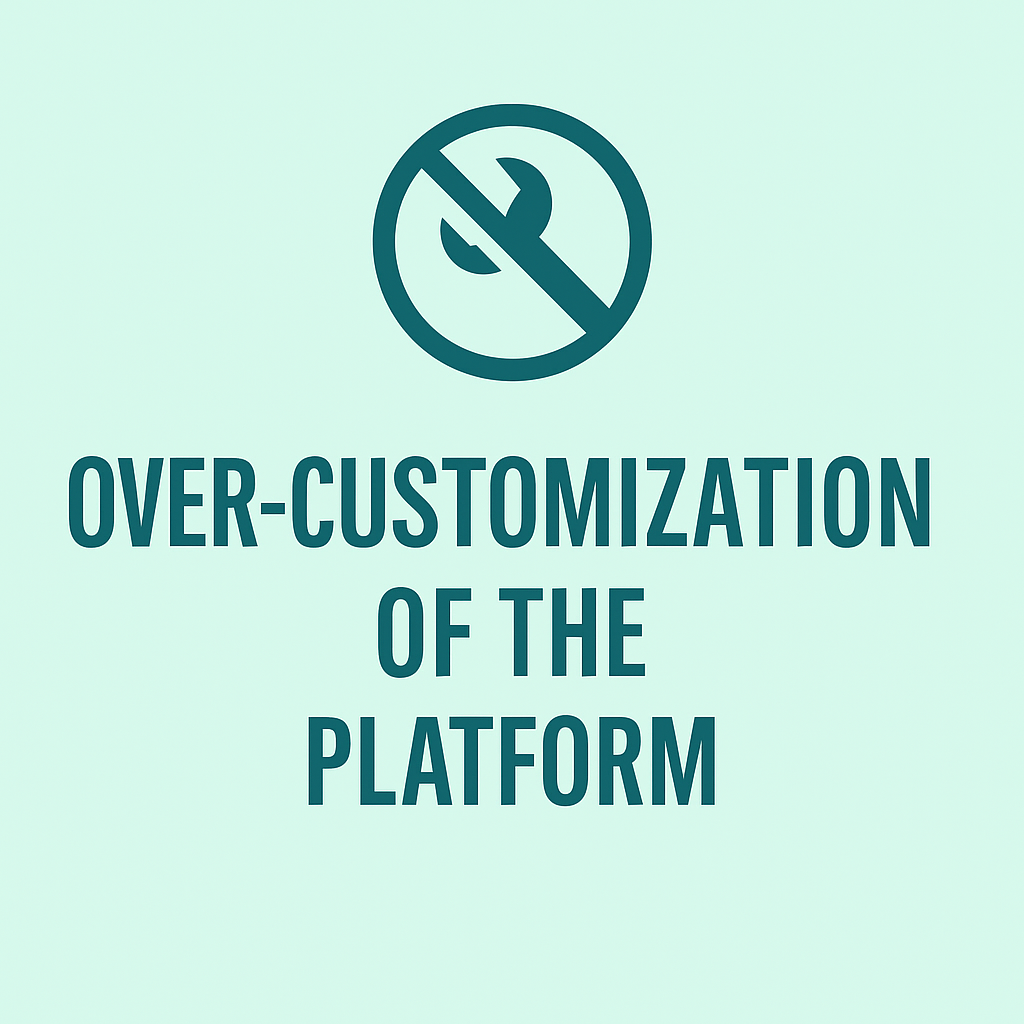
When configuration turns into chaos
The spiral often begins innocently. A sales director wants a new field to track competitor involvement in deals. Marketing insists on a custom object to measure campaign performance. Customer service demands a bespoke workflow to route high-priority cases. Each addition appears justified. Each change addresses a specific stakeholder’s concern.
But when requests are granted without strategic oversight, Salesforce slowly transforms into a Frankenstein’s monster of configuration. Fields multiply across objects until pages resemble cluttered spreadsheets. Workflows overlap, sometimes firing in contradictory ways, creating errors that administrators struggle to trace. Custom objects proliferate, fragmenting data and rendering reporting nearly useless.
The result is a brittle platform that collapses under its own complexity. Users, overwhelmed by irrelevant fields and unpredictable behaviors, begin to disengage. New employees require weeks of training simply to understand basic navigation. Scalability suffers, as a system designed for a few dozen users cannot withstand the demands of a global enterprise. Instead of empowering growth, Salesforce becomes a source of friction.
The best practice is restraint. Salesforce ships with a rich array of standard features—objects, automations, dashboards—that cover the majority of business needs. These should always be the first option. Customization should only be introduced when it delivers genuine differentiation, regulatory compliance, or measurable business value. For example, a pharmaceutical company may justifiably build a custom compliance-tracking process to meet FDA requirements. But creating ten slightly different lead qualification objects across business units is wasteful and counterproductive.
Over-customization doesn’t just confuse users; it actively cripples scalability. Systems designed in this way may work for a time but inevitably crack when organizations attempt to scale or innovate.
Technical debt from unchecked development
Beyond visible clutter lies a more insidious threat: technical debt. This is the invisible tax paid for poorly planned or hastily implemented customizations. It accrues silently, until one day the cost of innovation becomes prohibitively high.
Technical debt manifests in many ways:
- Hard-coded rules that must be manually updated whenever a process changes.
- Duplicate workflows and triggers that overlap, creating cascading failures when they collide.
- Unmanaged code written without documentation, leaving future administrators guessing at intent.
- Redundant objects that splinter data and undermine reporting accuracy.
At first, these shortcuts seem harmless. A developer meets a deadline by hardcoding a value instead of creating a configurable setting. An administrator builds three overlapping workflows because it feels faster than consolidating them into one. But each quick fix adds weight to the system. Over months and years, the accumulated debt slows down development, increases the risk of breakage, and discourages innovation.
The consequences are severe. A new product launch is delayed because the quoting process breaks under changes. An integration fails because a brittle, undocumented workflow can’t handle new data formats. A Salesforce release introduces features that the organization cannot leverage because legacy customizations conflict with them.
The organizations that avoid these pitfalls treat development like architecture, not ad-hoc construction. They design with foresight, not expedience. They enforce coding standards, ensuring that every customization aligns with best practices. They mandate documentation so that no process lives only in one developer’s head. They invest in governance frameworks, such as a Center of Excellence, to review requests and weigh them against long-term strategy.
By keeping debt under control, these organizations preserve agility. They can scale without fear, adopt new features quickly, and evolve with confidence. Instead of Salesforce being a rigid, fragile platform, it becomes a resilient engine for innovation.
Neglecting User Adoption
Treating training as an afterthought
A Salesforce system without adoption is a museum piece—impressive but unused. Many organizations assume users will “figure it out,” providing only minimal onboarding. The reality? Salesforce requires tailored training for different roles.
Sales reps need to understand pipeline management. Service agents must master case resolution workflows. Executives need confidence in dashboards. Training isn’t an afterthought; it’s the fuel for adoption.
Resistance to change within teams
Humans resist change, especially when they perceive new systems as surveillance tools. If Salesforce is framed as a way for managers to monitor every keystroke, employees push back. Adoption requires cultural buy-in: positioning Salesforce as an enabler, not a spyglass.
Engagement strategies—like involving users in design decisions or celebrating early wins—help overcome resistance.
Failing to Prioritize Change Management
Communication gaps
Change without communication breeds confusion. Users must know not only what is changing, but why. When this is neglected, rumors fill the void: “Salesforce is here to replace jobs,” “It’s just another failed IT project.”
Clear communication dispels fear and creates momentum. Every milestone should be shared transparently, with messaging that emphasizes benefits.
Mismanaging expectations
Overpromising transformation within weeks sets projects up for disappointment. Realistically, Salesforce adoption is a journey. Setting phased goals—like improving lead capture in phase one, expanding analytics in phase two—creates credibility and builds trust.
Misjudging Integration Complexity
Overlooking external systems
No Salesforce implementation exists in isolation. Most organizations must integrate marketing automation, ERP, HR, or financial systems. Underestimating integration scope leads to duplicate data entry and broken processes.
Imagine a manufacturing company that neglects to link Salesforce with its ERP: sales promises delivery timelines that production cannot fulfill. Misaligned systems destroy customer trust.
Building fragile connections
Quick, point-to-point integrations seem efficient but are brittle. They fail under load or during upgrades. A mature integration strategy—leveraging middleware, APIs, or platforms like MuleSoft—ensures durability. Integration should be designed, not improvised.
Inadequate Security and Compliance Planning
Poor role hierarchy design
Security is often an afterthought, but in Salesforce it should be foundational. Poorly designed role hierarchies expose sensitive information or block access to critical data. Either scenario erodes user trust.
Security must reflect business reality: sales leaders should see forecasts, but not individual employee HR records; service agents should view cases, but not confidential financial details.
Ignoring regulatory frameworks
Compliance cannot be retrofitted. Organizations bound by GDPR, HIPAA, or FINRA must embed controls into Salesforce from day one. Audit trails, data masking, and retention policies aren’t optional—they are survival.
Failure here risks not only fines but reputational ruin.
Skipping a Phased Rollout
The “big bang” miscalculation
Launching Salesforce across every function at once may seem efficient. In reality, it’s perilous. Failures in one area ripple across others, undermining confidence.
Why incremental wins matter
Phased rollouts reduce risk. Starting with core sales processes, then expanding to service or marketing, allows teams to celebrate quick wins. These victories build momentum, proving the system’s value and encouraging broader adoption.
Not Accounting for Scalability
Short-term fixes that collapse under growth
Many implementations focus on immediate needs—only to crumble when the organization grows. Custom workflows designed for 20 users may collapse under 200.
Future-proofing with architecture discipline
Scalable design means anticipating growth: new business units, acquisitions, product lines, and geographies. Architecture must be elastic, ready to absorb complexity without collapsing.
Overlooking Reporting and Analytics Setup
Dashboards that don’t tell the truth
Dashboards overloaded with vanity metrics—page views, lead counts, raw numbers—create noise. What leaders need are actionable insights: conversion rates, pipeline velocity, revenue at risk.
Failing to measure ROI
A Salesforce implementation must justify itself. Without ROI metrics—like cost savings, deal velocity improvements, or customer retention rates—the platform is seen as an expense, not an investment. Measurement secures ongoing support.
Poor Vendor or Partner Selection
Choosing low-cost over capability
Some organizations choose partners on price alone. But low-cost providers often deliver generic, underwhelming solutions that cost more to fix later.
Ignoring industry expertise
A partner who knows the regulatory nuances of healthcare or the supply chain intricacies of manufacturing brings irreplaceable value. Industry knowledge accelerates delivery and prevents costly mistakes.
Unrealistic Timelines and Budgets
Scope creep as a silent assassin
Mid-project, new demands appear: “Let’s add CPQ,” “Let’s redesign service.” Without adjusting budgets or timelines, projects collapse under scope creep.
Failing to resource test cycles properly
Testing is the safeguard of quality, yet it is often cut to save time. The result: bugs in production, frustrated users, and expensive rework. Robust testing protects credibility.
Neglecting Mobile-First Experience
Disconnected field teams
Sales reps and service technicians rely on mobile access. If Salesforce mobile experiences are neglected, frontline workers remain disconnected, undermining adoption.
Missed opportunities for real-time visibility
Mobile-first design empowers instant decision-making. A rep who updates a deal from the road ensures leadership has accurate forecasts. Neglecting mobile forfeits agility.
Weak Governance Structures
No center of excellence
Without governance, every department configures Salesforce their own way. The result: chaos. A center of excellence enforces standards, ensures reusability, and spreads best practices.
Lack of standardized processes
Inconsistent naming conventions, duplicate fields, and redundant workflows slow adoption. Governance imposes order, ensuring Salesforce remains coherent.
Failure to Leverage Automation Properly
Salesforce automation is a powerful lever for efficiency. It can reduce repetitive tasks, speed up response times, and ensure processes are consistent across teams. Yet, like any powerful tool, it must be wielded with balance. Too much automation creates fragility; too little leaves untapped potential.
Over-automation leading to complexity
In their enthusiasm, some organizations automate everything in sight. Dozens of workflows, process builders, and triggers fire simultaneously, often in conflicting ways. A lead update sparks a chain reaction that alters related records, which in turn launches another process, and suddenly the system is stuck in a loop. Users see unpredictable results, errors multiply, and trust in the platform erodes. What was intended to simplify work ends up complicating it.
The lesson is restraint. Automation should enhance clarity, not obscure it. Each process must serve a clear purpose, be documented, and be tested rigorously to avoid unintended consequences.
Missing simple wins in workflow automation
On the other hand, many organizations fail to exploit obvious opportunities. They overlook automation for routine yet critical tasks—like routing new leads to the right salesperson, escalating service cases that breach SLAs, or sending renewal reminders before contracts expire. These are low-effort, high-impact automations that free up human attention for higher-value work.
Balanced automation delivers the best results. It handles the repetitive and predictable while leaving room for human judgment in areas that require nuance. The goal is not to replace people but to empower them—removing drudgery so they can focus on strategy, relationships, and growth.
Not Preparing for Continuous Innovation
Ignoring Salesforce releases
Salesforce evolves three times a year. Organizations that fail to review release notes and adapt lose competitive ground. Features stagnate, users grow frustrated, and innovation bypasses the business.
Treating implementation as “one and done”
Salesforce is a living ecosystem. Treating go-live as the finish line is a costly error. Continuous improvement must be part of the DNA, with ongoing iteration and enhancement.
Overlooking Support and Maintenance
No plan for ongoing admin
Without dedicated administrators, Salesforce deteriorates. Workflows break, permissions drift, and users abandon the system. Admins are custodians, ensuring Salesforce remains vibrant.
User feedback falling into a void
When user concerns go unheard, enthusiasm wanes. A structured feedback loop ensures the platform evolves with the organization, sustaining adoption over time.
Conclusion: From Avoidable Missteps to Sustainable Success
Salesforce, when implemented with discipline, becomes more than a CRM—it becomes the backbone of business transformation. But without foresight, governance, and balance, the platform can just as easily devolve into clutter, confusion, and wasted investment. The difference between the two outcomes lies not in the technology itself, but in how organizations approach it.
Avoiding rushed discovery, enforcing data discipline, restraining customization, fostering user adoption, and balancing automation—these are the practices that separate successful Salesforce journeys from costly failures. Implementation is not a one-time project; it is a living process of alignment, iteration, and continuous improvement.
And this is where the right partner makes all the difference.
At CloudVandana, we help organizations sidestep these common pitfalls and unlock Salesforce’s true potential. Our certified experts design implementations with scalability in mind, automate workflows without overcomplication, and ensure user adoption through tailored strategies. From data migration to long-term governance, we bring the architectural foresight and industry expertise needed to transform Salesforce into a resilient growth engine.
👉 If you’re ready to avoid missteps and turn Salesforce into your organization’s competitive advantage, partner with CloudVandana today . Strategy, execution, and sustainable success—delivered.

Atul Gupta is CloudVandana’s founder and an 8X Salesforce Certified Professional who works with globally situated businesses to create Custom Salesforce Solutions.
Atul Gupta, a dynamic leader, directs CloudVandana’s Implementation Team, Analytics, and IT functions, ensuring seamless operations and innovative solutions.



